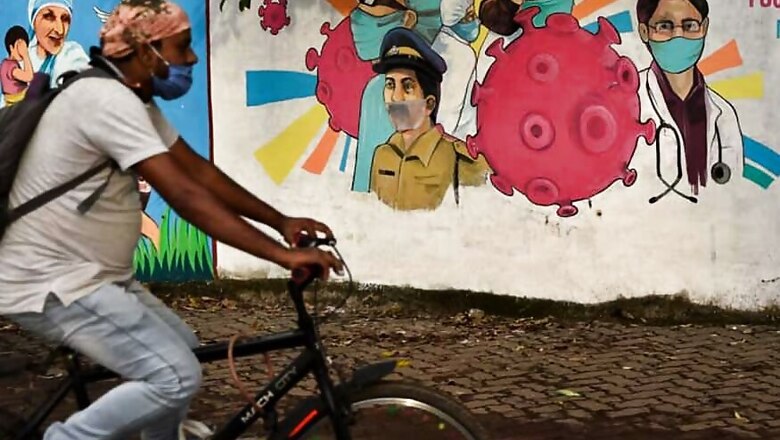
views
When the Covid-19 pandemic hit India, many policymakers initially thought it is not going to affect us badly. Some even ventured into pseudo-scientific theories --with no backing by data -- that the virus will be destroyed by the tropical heat of the Indian summer.
However, the virus hit us, and hit us hard. Megacities such as Delhi, Mumbai and Chennai were hit the hardest, though some like Bengaluru were comparatively spared. As the epidemic progresses, south Indian states except Tamil Nadu, though affected badly, have the semblance of an organised effort at containment.
And of all the states in India, Kerala has stood out with an exemplary performance in terms of containing the epidemic and restricting the death toll. This has won accolades from all over the world. Once non-resident citizens started coming back from parts of the world ravaged by the novel coronavirus, there has been a partial resurgence of the pandemic in the state, with new cases being reported in hundreds every day. However, even now, its performance stands out compared to the rest of India. This again was the outcome of a solid foundation of investment in healthcare.
Both Travancore and Kochi, princely states in colonial India that later became part of Kerala, had strong public health traditions. These states also developed departments of modern medicine as early as the 19th century.
Dr Mary Punnen Lukose, the Durbar Physician in Travancore in early 20th century, adorned one of the highest posts under princely rule. The Rockefeller Foundation, the American charity, initiated extensive health surveys in Travancore in the 1930s which reported that worm infestation was rampant among both adults and children in the state. Dr Krishnan Thampi was deputed to the Johns Hopkins University to study public health. He returned with a doctorate in public health and started a primary health centre in Neyyattinkara, near Trivandrum. This was probably the first primary health centre in India.
Development in education paralleled development in health. Providing access to primary and secondary education to people was a hard-won right in Travancore and Kochi, and to a certain extent, Malabar. This was promoted by religious reformers, missionaries and the state. There were struggles to promote the entry of women and lower castes in schools. All social reform movements in the state emphasised education. This would later prove beneficial for acceptance of good healthcare.
State Performance in Healthcare
By 1957, when Kerala was formed, it already had better statistics with regard to education, health, birth and death. Over the years, successive state governments spent a large proportion of their expenditure on these ‘service’ sectors.
The share of public spending on health in Kerala was one of the largest among Indian states in the early 60s and 70s. By 1975, the state had modern medical institutions such as PHCs or government dispensaries in almost every one of its nearly 1,000 panchayats. The network of roads and easy transportation which also resulted from government investment made sure that these health institutions were easily accessible.
There was great demand for healthcare from the common people, especially from women and children. Childbirths were happening more and more in healthcare institutions rather than homes. The strides in women’s education helped as the taboos against women stepping out of homes were fast disappearing.
International scholars commented on the fact that absence of a doctor in a primary health centre elicits public protests in Kerala, a situation hardly imaginable in other states in India even now. Thus, the great edifice of public healthcare in Kerala was built by public action.
Growth of the Private Sector
By 1985, the growth of revenue-expenditure by the state, largely going to salaries of staff, squeezed the spending on infrastructure and consumables, affecting the quality of care. This affected the secondary tier of taluk and district hospitals the worst, since PHCs were supported through family welfare funds from the Government of India, and the tertiary tier of medical colleges received priority from the state government.
Since the public continued to demand hospital care, the situation provided ample scope for the growth of a thriving private sector in health. By the latter half of the 90s, the facilities in private institutions had outgrown those in government institutions; a larger proportion of the public also preferred private care.
Around this time, the government started approaching external agencies for loans to develop the health system, and the World Bank in its philosophy of encouraging private initiative put pressure to restructure the government health system, significantly for introduction of user fees. This happened in many Indian states; however, in Kerala, this was resisted by a strong coalition of civil society organisations.
Decentralisation of Healthcare and Emergence of the Panchayats
One important piece of legislation in Kerala was instrumental in changing the face of healthcare once again: the decentralisation of power to the panchayats and other local bodies. This brought the health institutions under the direct administration of the local bodies, and also provided more funds for them.
Many local bodies utilised this opportunity to improve the facilities in hospitals. This was the beginning of a revival of the public sector in health in Kerala. There was initial resistance to the idea of working with local politicians on the side of the medical professionals; this gave way to strong partnerships between the local health administration and the local political administration in many panchayats and municipalities, raising their health institutions in terms of facilities to a level rarely seen in public hospitals in India.
Many central government funding channels such as the National Rural Health Mission (NRHM) and the RSBY, the insurance scheme for the poor, were much better utilised in Kerala compared to other states, because of this effective partnership.
In recent years, 10-20% of people have moved back to the public sector for their healthcare. The government has taken the initiative to make healthcare much more accessible at the local level through the Ardram mission. More sophisticated care is available at taluk and district hospitals as well as government medical colleges.
Successive governments have provided improved funding for care at different tiers of government institutions. This has been facilitated in recent years by committed political leadership in the health sector, supported by competent bureaucracy, helping the state to weather repeated challenges posed in recent years by two devastating floods as well as the threat of the Nipah virus. These have provided the run-up to the strong containment of the Covid-19 epidemic that the world has noticed.
(The author is an epidemiologist and data science consultant. Views are personal)


















Comments
0 comment